
With no pro games played in New Zealand since March 14th due to the COVID-19 quarantine, the return of Super Rugby Aotearoa has been hotly anticipated over these last three months. This article looks at how Blues and Hurricanes kicked off their rugby restart, the positive reasons used for kicking by both teams and the pivotal part the skill had in deciding the contest.
<->
We start our examination of the kicking duel by looking at a Hurricanes lineout just outside the Blues 22 metre line in the 11th minute.
After winning a penalty, the Canes kick to touch for a lineout. Having won their own throw, the Canes look to move the ball into the centre of the field in order to split the defence, draw the covering wingers up and create a strong kicking platform.
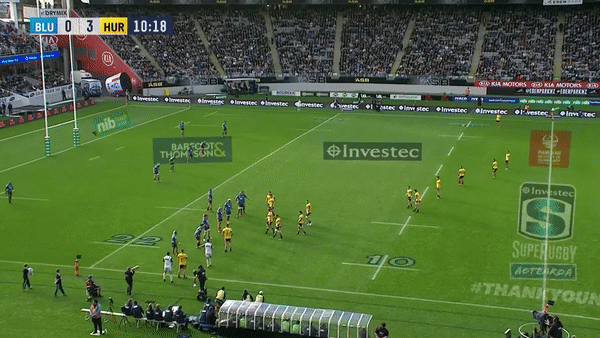
As the GIF above shows, two crunching tackles from Blake Gibson and Ofa Tu’ungafasi stymie the progress of the Hurricanes initially. However, what we want to focus on first is what happens out of contact at the end of the clip in the picture below.

As Tu’ungafasi puts in the second tackle, TJ Faiane looks up and assesses where the Hurricanes are going to attack next. With only three yellow backs folding around the ruck and the Blues set with four already; Faiane signals for his teammates to be alive on the right side of the defence to any potential switch of direction in play.
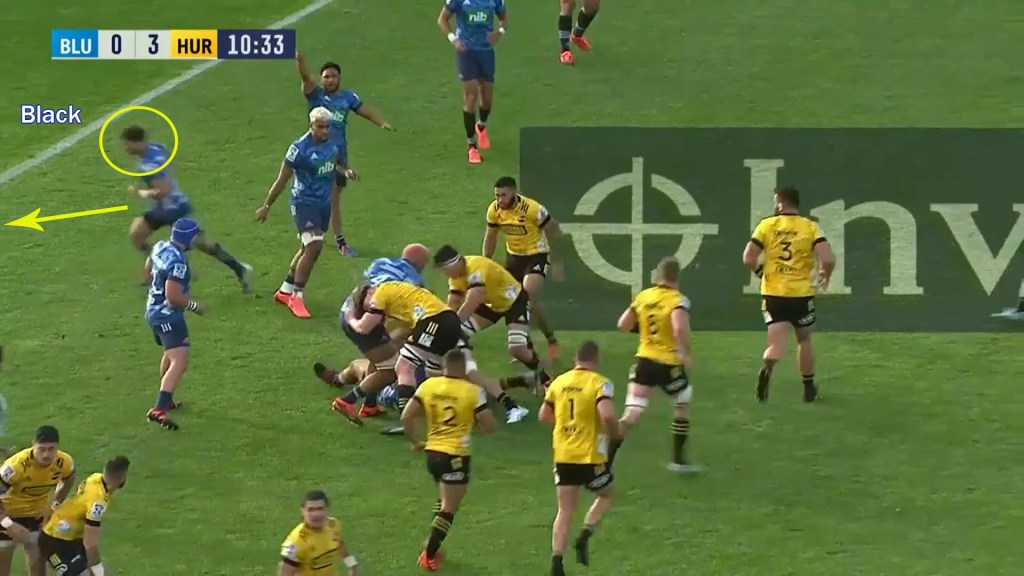
Agreeing with Faiane’s call, Blues 10 Otere Black – circled above – runs back to cover the switch that his teammate is anticipating.
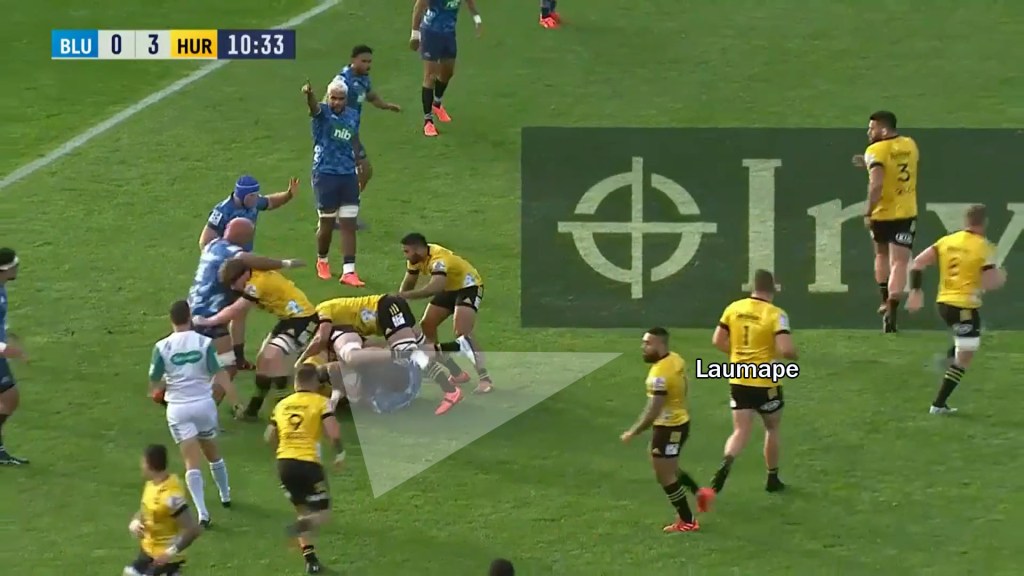
Meanwhile – in what seems like a pre-called play – the Canes’ Ngani Laumape doesn’t fold around the ruck and scans to see where the space is on the Blues blindside with goal of kicking to transfer pressure onto the Blues defence in the next phase for a positive return.
As we roll on the play in the following GIF, we can see that Laumape receives the ball from a relatively flat starting position and kicks the ball early.
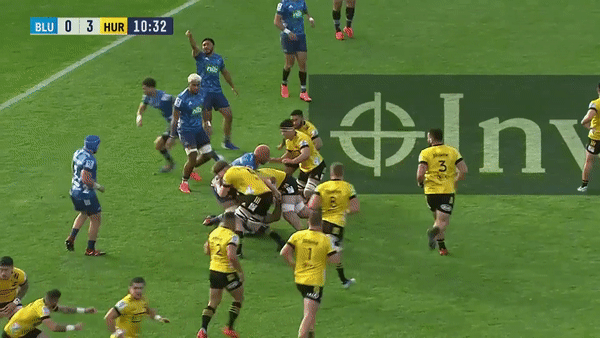
However, the earliness of the kick, flatness of the Canes left-side attack and excellent anticipation of the Blues defence 5 seconds beforehand leads to Laumape’s kick being well-covered by Otere Black and company.

Moreover, having effectively snuffed out the Canes kicking threat, Black offers a marvelous riposte with his own kick for territory that sends the play over 50 metres up the pitch in the other direction.

In the first major kicking battle of the game; where the Hurricanes kicked to transfer pressure onto the Blues and the Blues kicked for territory, the home side are the clear winners.
Black’s territory gain pays off twofold in the next run of play as, after fumbling at the subsequent lineout, the Hurricanes’ 10 Jackson Garden-Bachop rushes a high 22 exit kick to relieve pressure.

As the screenshot below shows, although the Hurricanes effort to chase is good; kicking from a position of relative weakness – and a lack of scanning in defence – compromises their ability to number up correctly at the next ruck.
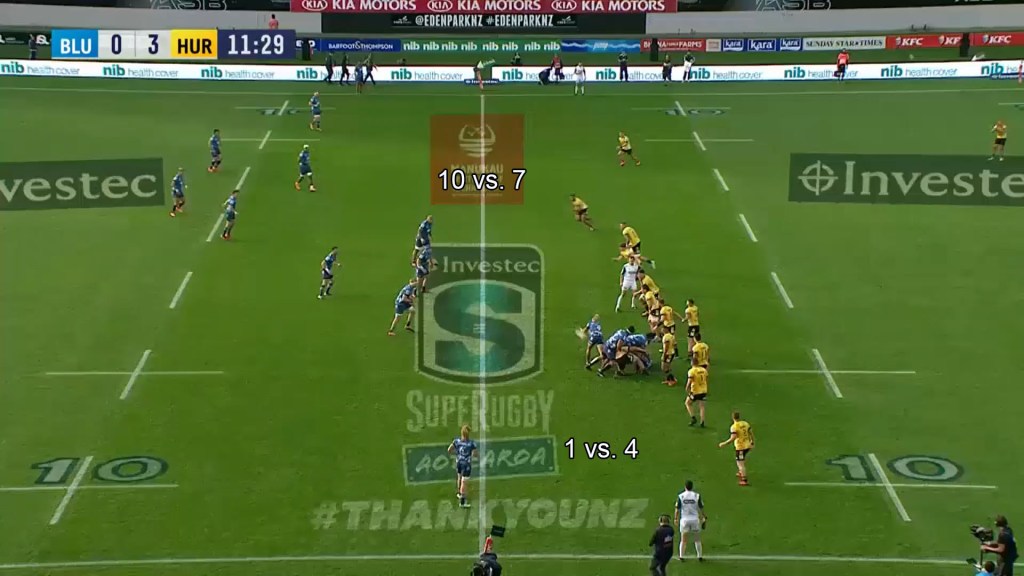
Which the Blues ruthlessly punish on the next phase by – you guessed it – attacking to the left.

<->
10 minutes later, we again see the influence that a strong kicking game can have in deciding the momentum of a game.
As the Hurricanes restart after conceding their second try, they look to kick long. Generally speaking, the target zone for most kickers in this scenario is the spaces between two groups of defenders – in order to create confusion between potential catchers.

If we look at the image above, this confusion and pressure is amplified for catchers if the kick is close to the touchline in the 5 metre zone where catchers can be tackled over the sideline.
As we let the play run on, we see below that the Canes don’t manage to hit this 5m zone with their kick and are quite passive with their linespeed. This allows Caleb Clarke time to catch and carry powerfully into the Canes defenders.

The knock-on effect of this lack of pressure on Clark is that the Blues can commit less forwards to the ensuing ruck and use the others to create a strong midfield kicking platform instead.

Having brought the ball back into the 22, Otere Black cannot kick the ball out directly. As a result, he looks to deliver a long high kick to transfer pressure, from the Blues deep in their own half, back onto the Hurricanes cover defence.
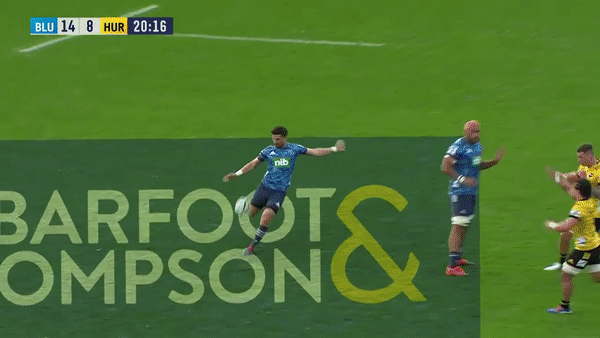
If we throw our mind back to the previous screenshot we know that, despite astutely reading Black’s kick, Garden-Bachop is now under pressure as he catches the ball in the 5m zone below.

This pressure tells as the chasing Blues backs drag Garden-Bachop over the sideline for a positive return, with help from white-haired no. 8 Hoskins Sotutu – who was free after the Canes original kick and chase allowed the Blues pack to fan out.

<->
Whereas the Blues approach to kicking largely revolved around tackling players post-catch, the Hurricanes did have some success with a contrasting kicking to contest approach last weekend.
Although the Canes have been driven backwards after another messy lineout win in the picture below, this time Garden-Bachop can kick on his own terms with a wall of four forwards ahead of him.

With a midfield ruck set, Caleb Clark is drawn up a little on the Blues left wing. This opens up a space behind him for the Hurricanes 10 to kick into, preferably while getting a 4 second hang-time. Those 4 seconds in turn then give teammate Wes Goosen a chance to cover 20 metres and contest the catch.
As the GIF below shows, Garden-Bachop delivers perfectly in that regard with Goosen able to run onto the ball, win the contest and palm the ball back for flanker Reed Prinsep to collect. Originally backtracking rapidly, the Hurricanes kick to contest now puts them on the front foot against a disorganised defence.

TJ Perenara and the Hurricanes would have success with a similar kick to contest in the second half as they exited their own half, again making a territorial gain as the ball comes to the ground.

<->
However, despite some successful kicks gaining the Hurricanes positive metres up the pitch, the most telling kick of the game belonged to the Blues and centre TJ Faiane.
In a situation that is remarkably similar to the opening kick we looked at from Ngani Laumape, the Blues kick a penalty to touch just outside the Hurricanes 22.
As the Canes set up defensively in the screenshot below, winger Wes Goosen is positioned in the 10 position with Garden-Bachop marking the right touchline.

The resulting lineout is won after an athletic one-man lift on Dalton Papali’i by Alex Hodgman and the Canes defence sets in motion. However, another muscular carry from Caleb Clarke gets the Blues on the front foot.

Which is then backed up by another decent carry from Tom Robinson who uses strong leg drive to establish a secure midfield ruck with minimum fuss.
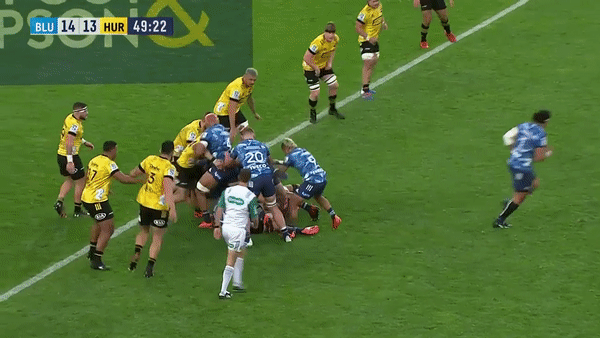
These two forward carries allow the Blues to pose genuine threats on either side of the ruck – and for perceptive players such as TJ Faiane -circled below – to call the ball to himself in space as the opportunity arises.

With Faiane standing deep at first to keep both the pass and kick options open, the narrowness of the Canes defence around the ruck compels Garden-Bachop to make a difficult snap decision. In an identical covering position to Otere Black almost 30 minutes earlier, but arguably under far more pressure, Garden-Bachop must cover or come into the line.
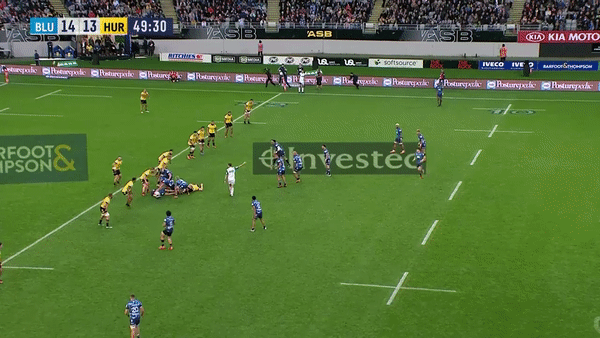
As Faiane dummies a pass at first, he receives a helping hand from Papali’i to make his own decision – who points to the kick space as Faiane looks up again in the image below.

Whereas Laumape kicked too early with his own effort in a similar scenario, it’s a devastatingly late kick to score from Faiane, threaded through delicately for Papali’i to collect and cross the try-line.

<->
As this article has looked to convey, although teams kicking the ball can sometimes be perceived as negative, the skill can also be used in positive ways too; to exert pressure, for territorial gain, to contest and to score. Furthermore, while the effectiveness of a kick is often judged by the result, as the Blues showed last Sunday, it can additionally be helped by players scanning and communicating where the space is.
Even though the New Zealand teams are known moreso for their running rugby, it will be worthwhile keeping a close eye on how they continue to use the boot this weekend.
<->
If you want to read some of our other posts on the website, you can click on the ‘Index’ icon at the top of the page to see a list of all the other analysis pieces from us.
Support EK Rugby Analysis
If you would also like to support us financially and lessen the running costs involved with the producing analysis pieces every month, you can do so with this PayPal link – paypal.me/ekrugbyanalysis1 – or click below to donate €2.
Support EK Rugby Analysis
If you enjoy what we do and would like to support EK Rugby Analysis, you can click below on your preferred method of payment to donate €2
€2.00
